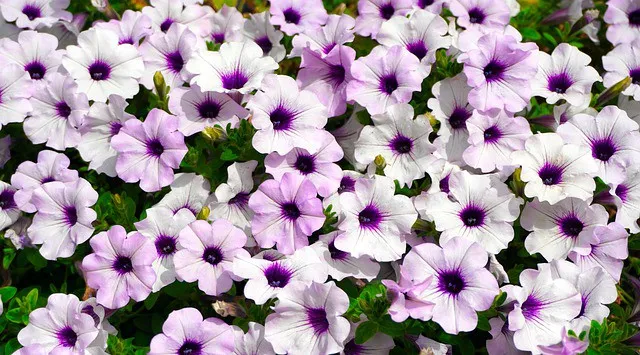Petunias, celebrated for their vibrant and abundant blooms, are versatile annuals that can elevate the beauty of any garden or landscape. This expert guide offers a comprehensive approach to cultivating healthy and flourishing petunias, integrating insights from authoritative government and horticultural bodies, as well as academic experts.
Selecting Petunia Varieties
Begin by choosing petunia varieties suited to your garden’s aesthetic and local climate. Utilize resources from the United States Department of Agriculture (USDA) to understand plant hardiness zones and explore recommendations for different petunia cultivars.
Soil Preparation and pH Adjustment
Petunias thrive in well-drained, fertile soil. Conduct a soil test and amend the soil with organic matter to ensure optimal growing conditions. Adjust the pH level to slightly acidic or neutral, following guidelines from your local Agricultural Extension Service.
Starting Petunia Seeds Indoors
Initiate the growing process by starting petunia seeds indoors 10-12 weeks before the last expected frost. Use high-quality seed-starting mix, and follow academic recommendations for germination and seedling care.
Transplanting Seedlings
Transplant petunia seedlings into the garden after the last frost, ensuring proper spacing (10-12 inches apart) for healthy growth. Refer to specific recommendations from horticultural experts for each petunia variety.
Sunlight Requirements
Petunias thrive in full sunlight, receiving at least 6 hours of direct sunlight each day. Ensure they are planted in a location with adequate exposure, considering regional climate conditions.
Watering Practices
Maintain a consistent watering schedule, allowing the soil to dry slightly between waterings. Apply water at the base of the plants to prevent fungal diseases. Follow watering guidelines from the National Gardening Association (NGA) for optimal practices.
Fertilization Techniques
Consult soil test results and fertilize petunias with a balanced, water-soluble fertilizer every 2-3 weeks during the growing season. Avoid over-fertilization, which can lead to excessive foliage growth. Academic experts in horticulture can provide specific nutrient recommendations.
Deadheading for Continuous Blooms
Encourage continuous flowering by deadheading spent blooms regularly. Follow guidelines from your local university’s cooperative extension services for specific deadheading techniques.
Pest and Disease Management
Stay vigilant for common pests like aphids and caterpillars, as well as fungal diseases. Implement Integrated Pest Management (IPM) strategies outlined by organizations such as the National Integrated Pest Management Network (NIPMN) for sustainable control.
Container Gardening with Petunias
Explore the versatility of petunias in container gardens. Follow expert recommendations from horticultural bodies for soil mixes, container sizes, and proper care for thriving petunias in containers.
Conclusion
By integrating advice from government bodies, horticultural organizations, and academic experts, you can successfully cultivate vibrant and resilient petunias in your garden. Follow these expert guidelines for a rewarding petunia-growing experience.
Why should I choose petunias for my garden?
Petunias are versatile annuals known for their vibrant blooms, making them a popular choice for enhancing the beauty of gardens, hanging baskets, and container plantings.
When is the best time to start petunia seeds indoors?
Initiate the growing process by starting petunia seeds indoors 10-12 weeks before the last expected frost, ensuring robust seedlings for transplanting.
What type of soil do petunias prefer, and how should I prepare it?
Petunias thrive in well-drained, fertile soil. Amend the soil with organic matter and adjust the pH to slightly acidic or neutral based on recommendations from horticultural experts.
How do I transplant petunia seedlings, and what spacing is recommended?
Transplant petunia seedlings after the last frost, ensuring spacing of 10-12 inches between plants. Refer to specific recommendations from horticultural experts for each petunia variety.
Do petunias require full sunlight, and what if I have limited sunlight in my garden?
Petunias prefer full sunlight, but they can tolerate partial shade. Ensure they receive at least 6 hours of direct sunlight each day for optimal growth.
What is the best watering routine for petunias?
Maintain a consistent watering schedule, allowing the soil to dry slightly between waterings. Water at the base of the plants to prevent fungal diseases.
How do I fertilize petunias, and how often should I do it?
Consult soil test results and fertilize petunias every 2-3 weeks during the growing season with a balanced, water-soluble fertilizer. Avoid over-fertilization to prevent excessive foliage growth.
Why is deadheading important for petunias, and how should I do it?
Deadheading removes spent blooms, promoting continuous flowering. Follow guidelines from local university cooperative extension services for specific deadheading techniques.
What pests and diseases should I watch out for when growing petunias?
Monitor for common pests like aphids and caterpillars, as well as fungal diseases. Implement Integrated Pest Management (IPM) strategies outlined by organizations such as the National Integrated Pest Management Network (NIPMN).
Can I grow petunias in containers, and what care do they need?
Yes, petunias are well-suited for container gardening. Follow expert recommendations from horticultural bodies for soil mixes, container sizes, and proper care to ensure thriving petunias in containers.
- Explore THC Infused Drinks in New York - May 9, 2025
- The Latest in THC Seltzers Across Texas - May 9, 2025
- Top THC Infused Drinks Available in Oklahoma - May 9, 2025




